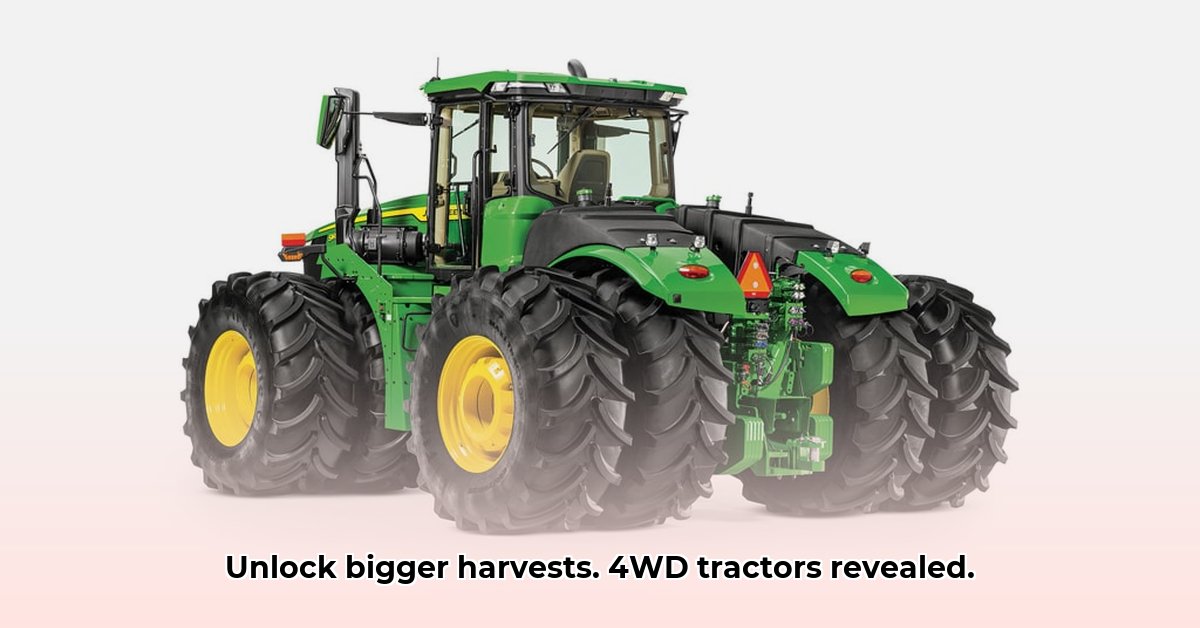
Understanding 4WD and MFWD Tractors: A Farmer's Guide to Choosing the Right Machine
Choosing the right tractor is a critical investment for any farming operation. This decision significantly impacts productivity, operational costs, and the long-term health of your land. This guide compares two popular options: four-wheel-drive (4WD) and mechanically front-wheel-drive (MFWD) tractors, helping you make an informed choice based on your specific needs and farming practices. We'll explore the strengths and weaknesses of each type, considering factors like fuel efficiency, maneuverability, and cost. For more tractor information, check out this helpful resource: tractor accessories.
4WD Tractors: Power and Traction for Demanding Conditions
4WD tractors are the workhorses of challenging terrains. Their superior traction makes them ideal for hilly landscapes, wet fields, and heavy-duty tasks.
Advantages of 4WD Tractors
- Exceptional Traction: 4WD provides maximum grip, minimizing wheel slip even in challenging conditions. This leads to increased efficiency and reduced time spent on each task. Think of navigating a muddy field during planting season – a 4WD tractor will consistently deliver.
- Superior Pulling Power: 4WD tractors excel at pulling heavy implements, like large cultivators or heavy wagons. This is crucial for tasks demanding significant power and consistent pull.
- Reduced Soil Compaction (Under Certain Conditions): While not always guaranteed, the reduced wheel slip in 4WD tractors can, in some cases, contribute to less soil compaction, promoting better soil health in the long run. It’s critical to consider soil type and operation techniques though.
Disadvantages of 4WD Tractors
- Lower Fuel Efficiency: The enhanced traction and power of a 4WD system often comes at the cost of higher fuel consumption compared to MFWD tractors.
- Reduced Maneuverability: Their robust build can make 4WD tractors less agile than MFWDs, particularly in smaller fields or when navigating tight spaces. This can impact efficiency with field maneuvering.
- Higher Initial and Maintenance Costs: Purchasing and maintaining a 4WD tractor typically involves higher upfront and ongoing expenses due to the more complex drivetrain.
MFWD Tractors: Efficiency and Maneuverability for Optimized Operations
MFWD tractors offer a balanced approach, combining good power with superior fuel efficiency and maneuverability - often making them a more practical option for many farming operations.
Advantages of MFWD Tractors
- Improved Fuel Efficiency: MFWDs generally consume less fuel than 4WD tractors, resulting in lower operating costs and a smaller environmental footprint.
- Enhanced Maneuverability: Their design allows for easier navigation in smaller fields and around obstacles, increasing efficiency and reducing the risk of damage to crops or equipment.
- Lower Initial and Maintenance Costs: The less complex drivetrain typically leads to lower purchase and maintenance costs compared to 4WD tractors.
Disadvantages of MFWD Tractors
- Limited Traction in Challenging Conditions: While suitable for many tasks, MFWDs may struggle in excessively wet or hilly conditions, or when pulling particularly heavy loads. Their traction is often sufficient for most farm tasks but falls short in extreme scenarios.
Comparative Analysis: 4WD vs. MFWD Tractors
The following table summarizes the key differences:
| Feature | 4WD Tractor | MFWD Tractor |
|---|---|---|
| Traction | Superior in challenging conditions | Good in most conditions |
| Maneuverability | Lower | Higher |
| Fuel Efficiency | Lower | Higher |
| Pulling Power | Higher | Lower; limitations in demanding conditions |
| Initial Cost | Higher | Lower |
| Maintenance Cost | Generally Higher | Generally Lower |
| Soil Compaction | Can be higher, depending on conditions | Generally lower |
Technological Advancements: Enhancing Both Tractor Types
Technological advancements, including GPS guidance, auto-steering, and variable-rate technology, are improving both 4WD and MFWD tractors. These precision farming tools enhance efficiency and resource management regardless of the drive system, offering benefits such as reduced fuel consumption and optimized input application.
Choosing the Right Tractor: A Decision-Making Framework
Selecting the appropriate tractor depends heavily on your unique farming operation. Consider these steps:
- Assess Your Terrain: Are fields predominantly flat or hilly? Challenging terrain necessitates a 4WD tractor.
- Evaluate Your Workload: Will you be pulling heavy implements regularly? Heavy-duty tasks demand the power of a 4WD.
- Analyze Your Budget: Factor in initial purchase price, fuel consumption, and maintenance costs over the tractor's lifespan. MFWDs often offer long-term cost savings due to better fuel efficiency.
- Consider Future Needs: How might your farm operations change? Choose a tractor that can adapt to future needs and potential expansion.
Conclusion: The Right Tractor for the Right Job
The choice between a 4WD and MFWD tractor is not a one-size-fits-all decision. Carefully analyzing your specific farming conditions, workload, budget, and long-term goals will ensure you select the tractor that maximizes productivity, profitability, and sustainability for your operation. Remember, consulting with agricultural equipment specialists can provide invaluable insights tailored to your individual circumstances.